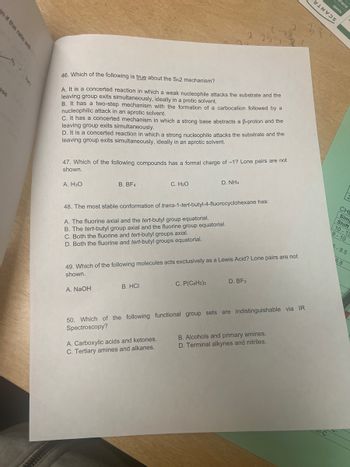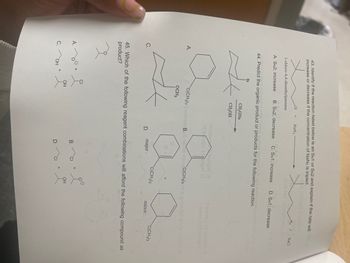
Chemistry
10th Edition
ISBN: 9781305957404
Author: Steven S. Zumdahl, Susan A. Zumdahl, Donald J. DeCoste
Publisher: Cengage Learning
expand_more
expand_more
format_list_bulleted
Question
Help with organic chem 1

Transcribed Image Text:n if the rate will
ase
Nac
2.25 J
2
rans
3WVN
BINVES
31
46. Which of the following is true about the SN2 mechanism?
A. It is a concerted reaction in which a weak nucleophile attacks the substrate and the
leaving group exits simultaneously, ideally in a protic solvent.
B. It has a two-step mechanism with the formation of a carbocation followed by a
nucleophilic attack in an aprotic solvent.
C. It has a concerted mechanism in which a strong base abstracts a ẞ-proton and the
leaving group exits simultaneously.
D. It is a concerted reaction in which a strong nucleophile attacks the substrate and the
leaving group exits simultaneously, ideally in an aprotic solvent.
47. Which of the following compounds has a formal charge of -1? Lone pairs are not
shown.
A. H3O
B. BF4
C. H₂O
D. NH4
48. The most stable conformation of trans-1-tert-butyl-4-fluorocyclohexane has:
A. The fluorine axial and the tert-butyl group equatorial.
B. The tert-butyl group axial and the fluorine group equatorial.
C. Both the fluorine and tert-butyl groups axial.
D. Both the fluorine and tert-butyl groups equatorial.
49. Which of the following molecules acts exclusively as a Lewis Acid? Lone pairs are not
shown.
A. NaOH
B. HCI
C. P(C6H5)3
D. BF3
CH
Sim
Shift
10-13
9-10
5-8.5
6.8
50. Which of the following functional group sets are indistinguishable via IR
Spectroscopy?
A. Carboxylic acids and ketones.
C. Tertiary amines and alkanes.
B. Alcohols and primary amines.
D. Terminal alkynes and nitriles.
l-C

Transcribed Image Text:43. Identify if the reaction listed below is an SN1 or SN2 and explain if the rate will
increase or decrease if the concentration of NaNз is tripled.
CI + NaN3
1-chloro-4,4-dimethylpentane
A. SN2; increase
N3 +
NaCl
otulib HO Onl/
B. SN2; decrease C. SN1; increase D. SN1; decrease
44. Predict the organic product or products for the following reaction.
Br
CH₂ONa
CH3OH HOT
VI 12ew JasrigiH.a
Il Jzewo;ll taerigiH A
Ill JapworlpiH.a
C(CH3)3 Snoitose B. 2 ns not main C(CH3)3r) ai gniwollot er to rainiW S
A.
OCH3
C.
+
C(CH)s
C(CH3)3
minor
D.
major
45. Which of the following reagent combinations will afford the following compound as
product?
из
A.
B.
CI
OH
C. OH
D.
CI
+
OH
Expert Solution
This question has been solved!
Explore an expertly crafted, step-by-step solution for a thorough understanding of key concepts.
Step by stepSolved in 2 steps with 4 images

Knowledge Booster
Similar questions
- Please answer 10-20arrow_forwardURGENT!!I will rate, pls need this. no need of long explanation.arrow_forwardThe following chemical equation is for a substitution reaction, where the important atoms and groups involved have been highlighted for you: Hot. way + H HO O. H* ? + H-OH Use the information provided to predict the missing organic product and draw its structure in the drawing area below. Make sure to use the same skeletal ("line") style for the structure as the rest of the equation. Click and drag to start drawing a structure. X :0 S Omarrow_forward
- Organic Chemistry 1 Here is the professor's solution to the problem. However, I do NOT understand the solution. Please explain the answer in a clear step-by-step fashion to me. Explain the answer provided in the image in a clear fashion and as if I did not know much about organic chemistry. It seems to me like the professor is making the problem more complicated than it has to be. Can you demystify or simplify this problem about D glucose? How can you assign priorities on a Fischer projection? I don't get it.arrow_forwardHello,can you help with with number 1 ,2 and 3 questions please.arrow_forwardThis question has multiple parts. Work all the parts to get the most points. For the reaction below: CH3CH₂O a Draw the major organic product. O HCI catalyst H₂O • Draw one structure per sketcher. Add additional sketchers using the drop-down menu in the bottom right corner. ChemDoodleⓇ Þarrow_forward
- Nucleophilic Substitution and Elimination. A Worksheet Lab. Pre-Lab 1. Identify the following organic transformations. Are they "substitutions" or "additions" or "eliminations"? Write formulas that clearly illustrate you selection. Pay attention to the organic part of the transformations. Example. Br ultraviolet light HBr + Br₂ formulas: CsH12 Br2 CsH11Br HBr This is a "substitution" reaction. H has been replaced (substituted) by Brarrow_forwardII. 7-10arrow_forward09:31 1. What is the correct IUPAC name for the following compound? O A. Diphenylamine O B. 1,1 diphenylamine OC.N,N-diphenylamine O D. None of the above is correct Add a caption... > Status (Custom)arrow_forward
- 5. Consider the reaction below and answer the following questions + OH + H₂O a. Draw in ALL missing lone pair electrons as well as electron movement arrows on the reactant side Identify the nucleophile and electrophile on the reactant side b. c. Identify which side of the equilibrium will dominate. d. Draw resonance structures for the organic compound on the product side CHEM 241-Group05. Ormord d ****arrow_forward[10 pts] For the below reaction: NH2 1) NANO,, HCI A 2) CUCN A 1) CH,CH,CH,MgBr B 2) H/ H,O* a) provide the structure of compound A. b) use the compound A to provide the structure of compound B. You can submit your answer as document file or image.arrow_forwardProvide the IUPAC namearrow_forward
arrow_back_ios
SEE MORE QUESTIONS
arrow_forward_ios
Recommended textbooks for you
 ChemistryChemistryISBN:9781305957404Author:Steven S. Zumdahl, Susan A. Zumdahl, Donald J. DeCostePublisher:Cengage Learning
ChemistryChemistryISBN:9781305957404Author:Steven S. Zumdahl, Susan A. Zumdahl, Donald J. DeCostePublisher:Cengage Learning ChemistryChemistryISBN:9781259911156Author:Raymond Chang Dr., Jason Overby ProfessorPublisher:McGraw-Hill Education
ChemistryChemistryISBN:9781259911156Author:Raymond Chang Dr., Jason Overby ProfessorPublisher:McGraw-Hill Education Principles of Instrumental AnalysisChemistryISBN:9781305577213Author:Douglas A. Skoog, F. James Holler, Stanley R. CrouchPublisher:Cengage Learning
Principles of Instrumental AnalysisChemistryISBN:9781305577213Author:Douglas A. Skoog, F. James Holler, Stanley R. CrouchPublisher:Cengage Learning Organic ChemistryChemistryISBN:9780078021558Author:Janice Gorzynski Smith Dr.Publisher:McGraw-Hill Education
Organic ChemistryChemistryISBN:9780078021558Author:Janice Gorzynski Smith Dr.Publisher:McGraw-Hill Education Chemistry: Principles and ReactionsChemistryISBN:9781305079373Author:William L. Masterton, Cecile N. HurleyPublisher:Cengage Learning
Chemistry: Principles and ReactionsChemistryISBN:9781305079373Author:William L. Masterton, Cecile N. HurleyPublisher:Cengage Learning Elementary Principles of Chemical Processes, Bind...ChemistryISBN:9781118431221Author:Richard M. Felder, Ronald W. Rousseau, Lisa G. BullardPublisher:WILEY
Elementary Principles of Chemical Processes, Bind...ChemistryISBN:9781118431221Author:Richard M. Felder, Ronald W. Rousseau, Lisa G. BullardPublisher:WILEY

Chemistry
Chemistry
ISBN:9781305957404
Author:Steven S. Zumdahl, Susan A. Zumdahl, Donald J. DeCoste
Publisher:Cengage Learning

Chemistry
Chemistry
ISBN:9781259911156
Author:Raymond Chang Dr., Jason Overby Professor
Publisher:McGraw-Hill Education

Principles of Instrumental Analysis
Chemistry
ISBN:9781305577213
Author:Douglas A. Skoog, F. James Holler, Stanley R. Crouch
Publisher:Cengage Learning

Organic Chemistry
Chemistry
ISBN:9780078021558
Author:Janice Gorzynski Smith Dr.
Publisher:McGraw-Hill Education

Chemistry: Principles and Reactions
Chemistry
ISBN:9781305079373
Author:William L. Masterton, Cecile N. Hurley
Publisher:Cengage Learning

Elementary Principles of Chemical Processes, Bind...
Chemistry
ISBN:9781118431221
Author:Richard M. Felder, Ronald W. Rousseau, Lisa G. Bullard
Publisher:WILEY